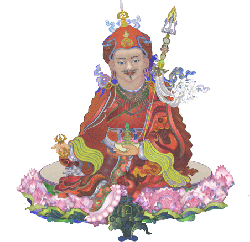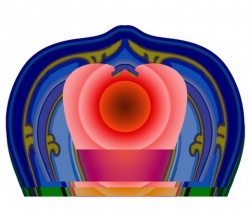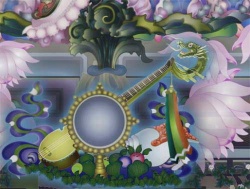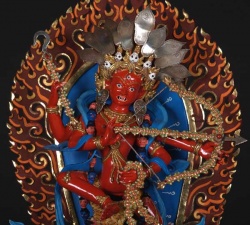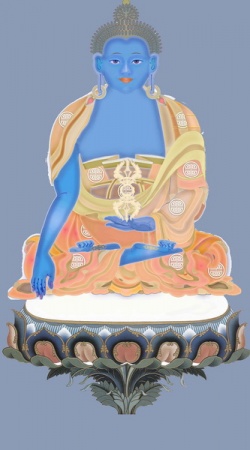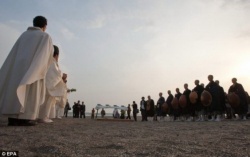Difference between revisions of "Charya tantra"
| (18 intermediate revisions by 3 users not shown) | |||
| Line 1: | Line 1: | ||
| − | [[File:Padma VTao.gif|thumb|250px|]] | + | [[File:Padma VTao.gif|thumb|250px|]]{{DisplayImages|1815|102|61|540|649}} |
| + | |||
| + | |||
| + | |||
| + | |||
| + | |||
| + | |||
| + | |||
| + | |||
| + | [[Charya tantra]] (Skt. [[caryātantra]]; Tib. {{BigTibetan|[[སྤྱོད་རྒྱུད་]]}}, [[Wyl.]] [[spyod rgyud]]) aka [[Upayogatantra]] or [[Ubhayatantra]] ({{BigTibetan|[[ཨུ་པའི་རྒྱུད་]]}}, [[u pa'i rgyud]]) is a [[classification of tantras]] within [[Tibetan Buddhism]]. | ||
| + | |||
| + | The [[vehicle of charya]] or ‘[[conduct’ tantra]] is so-called because it places an {{Wiki|equal}} {{Wiki|emphasis}} on the [[outer actions of body]] and [[speech]] and the inner [[cultivation]] of [[samadhi]]. | ||
| + | |||
| + | It is also called the ‘[[tantra of both]]’ (Skt. [[ubhaya tantra]]) because its view conforms with that of [[yoga tantra]], while its conduct is similar to that of [[kriya tantra]]. | ||
| + | |||
| + | The [[vehicle of charya tantra]] is identified within the following contexts: | ||
| + | |||
| + | the second of the three [[outer tantras]] within the [[nine yanas]] {{Wiki|classification}} of the [[Nyingma school]]he second of the four classes of [[tantra]] according to the [[Sarma schools]] | ||
| + | |||
| + | |||
| + | |||
| + | |||
| + | 1. [[Tatagata Family]]: | ||
| + | |||
| + | |||
| + | |||
<poem> | <poem> | ||
| − | Charya tantra, Upa tantra, or Ubhaya tantra is a yana (literally "vehicle") of Esoteric Buddhism-though there is debate about whether it is considered to be buddhism, and as such is both a class of tantric literature and of praxis. The yana of Charya or ‘conduct’ tantra is given this name because it demonstrates a balanced emphasis on the outer ritual actions and ablutions of body and speech and the inner cultivation of intentionality and mindfulness. Hence, outer and inner conduct | + | - [[Maha Vairochana Abhisambodhi Tantra]] |
| + | - [[Manjushri Mula Kalpa]] | ||
| + | - [[Siddhaikavira Tantra]] [[Arapachana Manjushri]] | ||
| + | </poem> | ||
| + | |||
| + | |||
| + | |||
| + | 2. [[Padma Family]]: | ||
| + | |||
| + | |||
| + | |||
| + | (There are no texts translated from an [[Indian language]] into [[Tibetan]] from this {{Wiki|classification}}) | ||
| + | |||
| + | |||
| + | |||
| + | 3. [[Vajra Family]]: | ||
| + | |||
| + | |||
| + | |||
| + | <poem> | ||
| + | - [[Vajrapani Abhisheka Tantra]] | ||
| + | - [[Nilambaradhara Vajrapani Tantra]] | ||
| + | - [[Vajrapatala Tantra]] | ||
| + | </poem> | ||
| + | |||
| + | |||
| + | The [[vehicle of charya tantra]] is identified within the following contexts: | ||
| + | |||
| + | the [[second of the three outer tantras]] within the [[nine yanas]] {{Wiki|classification}} of the [[Nyingma school]] | ||
| + | the [[second of the four classes of tantra]] according to the [[Sarma]] schools. | ||
| + | |||
| + | |||
| + | |||
| + | |||
| + | |||
| + | ==[[The vehicle of charya tantra]]== | ||
| + | |||
| + | |||
| + | |||
| + | |||
| + | [[Alak Zenkar Rinpoche]] explains the [[vehicle]] ([[yana]]) of [[charya tantra]] as follows: | ||
| + | |||
| + | The [[vehicle of caryā]] or ‘[[conduct’ tantra]] is so-called because it places an {{Wiki|equal}} {{Wiki|emphasis}} on the outer [[actions]] of [[body]] and [[speech]] and the inner [[cultivation]] of [[samādhi]]. | ||
| + | |||
| + | It is also called the ‘[[tantra of both]]’ ([[ubhaya tantra]]) because its view conforms with that of [[yoga tantra]], while its conduct is similar to that of [[kriyā]]. | ||
| + | |||
| + | I will now say a little about its entry point, view, [[meditation]], conduct and results. | ||
| + | |||
| + | |||
| + | |||
| + | ==Entry Point== | ||
| + | |||
| + | |||
| + | |||
| + | One is matured by means of the five [[empowerments]], which include the [[empowerments of the vajra]], [[bell]] and [[name]] in addition to the [[water]] and [[crown empowerments]], and then maintains the [[samayas]] of [[caryā tantra]], as described in the particular texts themselves. | ||
| + | |||
| + | |||
| + | |||
| + | ==View== | ||
| + | |||
| + | |||
| + | |||
| + | The view is determined in the same way as in the [[yoga tantra]], so it will be explained below. | ||
| + | |||
| + | |||
| + | |||
| + | ==[[Meditation]]== | ||
| + | |||
| + | |||
| + | |||
| + | One [[visualizes]] oneself as the [[samaya]] being and [[visualizes]] the [[wisdom deity]], who is regarded as a [[friend]], in front of oneself, and then practises the [[conceptual meditations]] on the [[syllable]], [[mudrā]] and [[form]] of the [[deity]], and the [[non-conceptual meditation]] on [[absolute]] [[bodhicitta]] by means of entering, remaining and [[arising]]. | ||
| + | |||
| + | |||
| + | |||
| + | ==Conduct== | ||
| + | |||
| + | |||
| + | |||
| + | The conduct here is the same as in [[kriyā tantra]]. | ||
| + | |||
| + | |||
| + | ==Results== | ||
| + | |||
| + | |||
| + | In the short term, one attains the [[common accomplishments]] and ultimately one reaches the level of a [[vajradhara]] of the four [[buddha families]], i.e., the three mentioned earlier plus the [[ratna family]]. | ||
| + | |||
| + | |||
| + | |||
| + | |||
| + | |||
| + | ==[[Within East Asian Buddhism]]== | ||
| + | |||
| + | |||
| + | |||
| + | |||
| + | The [[tantras]] within this category are also signficant within the {{Wiki|East Asian}} [[traditions]] of [[Shingon]] and [[Tendai]]. However these [[traditions]] follow a different classificaton system. | ||
| + | |||
| + | |||
| + | |||
| + | The [[Charya Tantra Classification]] although following the [[Kriya]] system of [[Three Buddha Families]], [[Tatagata]], [[Padma]] and [[Vajra]], has very few actual texts and very few [[deities]] and [[mandalas]]. | ||
| + | |||
| + | Not all of the [[Tibetan Traditions]] agree on the text titles found under [[Charya]]. | ||
| + | |||
| + | The [[Sakya Tradition]] includes The [[Manjushri Mulakalpa]] and [[Siddhaikavira Tantras]] as [[Charya]]. | ||
| + | |||
| + | Most other schools classify those texts as [[Kriya Tantra]]. | ||
| + | |||
| + | A [[deity]] such as [[Bhutadamara Vajrapani]] is found in both [[Charya]] and [[Anuttarayoga Tantras]]. | ||
| + | |||
| + | In the [[Charya Tantras]] he is a main [[deity]] where as in the [[Anuttarayoga Tantras]] he performs the function of a supporting [[deity]]. | ||
| + | |||
| + | |||
| + | |||
| + | [[Charya tantra]], [[Upa tantra]], or [[Ubhaya tantra]] is a [[yana]] (literally "[[vehicle]]") of [[Esoteric Buddhism]]-though there is [[debate]] about whether it is considered to be [[buddhism]], and as such is both a class of [[tantric]] {{Wiki|literature}} and of praxis. | ||
| + | |||
| + | The [[yana of Charya]] or ‘conduct’ [[tantra]] is given this [[name]] because it demonstrates a balanced {{Wiki|emphasis}} on the [[outer ritual actions]] and ablutions of [[body]] and [[speech]] and the inner [[cultivation]] of {{Wiki|intentionality}} and [[mindfulness]]. | ||
| + | |||
| + | |||
| + | |||
| + | |||
| + | ==[[Hence, outer and inner conduct]]== | ||
| + | |||
| + | |||
| + | |||
| + | |||
| + | The [[Charya tantra]] is enumerated as one of the three [[Outer Tantras]] in both the [[four-tantric-yanas]] {{Wiki|classification}} scheme of the [[Sarma]], or '[[New Translation Schools]]' and the [[nine-yana]] {{Wiki|classification}} of the [[Nyingma]], '[[Ancient Translation School]]'. | ||
| + | |||
| + | |||
| + | |||
| + | |||
| + | ==[[Charya Tantra]]== | ||
| + | |||
| + | |||
| + | |||
| + | |||
| + | The main [[Charya Tantra]] is the [[Mahavairocanabhisambodhi Tantra]] ([[tathagata lineage]]), in [[Japanese]] it is called the [[大日経]] ([[dainichikyou]]). | ||
| + | |||
| + | Two others are the [[Vajrapani Initiation Tantra]] ([[Vajra lineage]])and the [[Extensive Tantra of Hayagriva]] ([[lotus lineage]]). | ||
| + | |||
| + | Also the [[Arya Manjushri Root Tantra]] is a [[Charya Tantra]] text. | ||
| + | |||
| + | [[Upa]], or [[practice tantra]], is also called [[Ubhayatantra]], [[dual-tantra]], because it combines the [[view]] of the next [[vehicle]], [[Yoga tantra]], with the [[action]], or conduct, of [[Kriya tantra]], the former one. | ||
| + | |||
| + | The [[abhiseka]] consists of the [[empowerment]] of the [[Five Buddha Families]]. | ||
| + | |||
| + | [[Realization]] may be gained in five lifetimes. | ||
| + | |||
| + | |||
| + | [[Yana of charya tantra]] [[sanskrit]];[[caryātantra yāna]] [[tibetan]];{{BigTibetan|[[སྤྱོད་རྒྱུད་ཀྱི་ཐེག་པ་]]}} [[chögyü kyi tekpa spyod rgyud kyi theg pa]] | ||
| + | |||
| + | |||
| + | [[Charya tantra]] (Skt. ''[[caryātantra]]''; Tib. {{BigTibetan|[[སྤྱོད་རྒྱུད]]་}}, [[Wyl.]] ''[[spyod rgyud]]'') aka [[Upayogatantra]] or [[Ubhayatantra]] (Skt.; [[Wyl.]] ''[[u pa'i rgyud]]'') — the second of the [[three outer classes of tantra]] and the fifth [[yana]] according to the [[nine yanas|nine yana]] {{Wiki|classification}}. | ||
| + | |||
| + | The [[vehicle]] of [[charya]] or ‘conduct’ [[tantra]] is so-called because it places an {{Wiki|equal}} {{Wiki|emphasis}} on the outer [[actions]] of [[body]] and [[speech]] and the inner [[cultivation]] of [[samadhi]]. It is also called the ‘[[tantra]] of both’ (Skt. ''[[ubhaya tantra]]'') because its [[view]] conforms with that of [[yoga tantra]], while its conduct is similar to that of [[kriya tantra]]. | ||
| + | |||
| + | |||
| + | ==Overview Given by [[Alak Zenkar Rinpoche]]<ref>{{LH|tibetan-masters/alak-zenkar/nine-yanas|''A Brief Presentation of the [[Nine Yanas]]'' by Alak Zenkar Rinpoche}}</ref>== | ||
| + | |||
| + | |||
| + | |||
| + | ==[[Entry Point]]== | ||
| + | |||
| + | |||
| + | |||
| + | One is matured by means of the five [[empowerment]]s, which include the [[empowerments]] of the [[vajra]], [[bell]] and [[name]] in addition to the [[water]] and {{Wiki|crown}} [[empowerments]]<ref>Of the [[Kriya tantra]]</ref>, and then maintains the [[samayas of charya tantra]], as described in the particular texts themselves. | ||
| + | |||
| + | |||
| + | |||
| + | ==[[View]]== | ||
| + | |||
| + | |||
| + | |||
| + | |||
| + | The [[view]] is determined in the same way as in the [[yoga tantra]]. | ||
| − | + | ||
| − | + | ===[[Meditation]]=== | |
| − | + | ||
| + | |||
| + | |||
| + | |||
| + | One [[visualizes]] oneself as the [[samaya]] being (Skt. ''[[samayasattva]]'') and [[visualizes]] the [[wisdom deity]] (Skt. | ||
| + | |||
| + | ''[[jñānasattva]]''), who is regarded as a [[friend]], in front of oneself, and then practices the [[conceptual meditations]] on the | ||
| + | |||
| + | {{Wiki|syllable}}, [[mudra]] and [[form]] of the [[deity]], and the [[non-conceptual meditation]] on [[absolute bodhichitta]] by means of entering, remaining and [[arising]].<ref>‘ | ||
| + | |||
| + | |||
| + | |||
| + | Entering’ refers to the [[realization]] that all [[phenomena]] are beyond [[arising]], ‘remaining’ means to abide once the [[non-conceptual]] [[nature]] has [[manifest]] and ‘[[arising]]’ means developing intense [[compassion]] for all [[beings]] who do not realize this.</ref> | ||
| + | |||
| + | |||
| + | |||
| + | ===Conduct=== | ||
| + | |||
| + | |||
| + | |||
| + | The conduct here is the same as in [[kriya tantra]]. | ||
| + | |||
| + | |||
| + | |||
| + | ===Results=== | ||
| + | |||
| + | |||
| + | |||
| + | In the short term, one attains the [[Eight ordinary accomplishments|common accomplishments]] and ultimately one reaches the level of a [[vajradhara of the four buddha families]] (i.e., the three families mentioned in the results of the [[kriya tantra]] [[vehicle]] plus the [[ratna family]]) | ||
| + | |||
| + | |||
| + | [[Tibetan]]: {{BigTibetan|[[སྤྱོད་པ]]}}, [[Wylie]]: [[spyod pa]] | ||
| + | [[Caryā]] ([[Sanskrit]]), [[चर्या]] ({{Wiki|Devanagari}}) | ||
| + | |||
Guarisco & McLeod et al. (2005: p. 41) render this class into English as "Conduct". | Guarisco & McLeod et al. (2005: p. 41) render this class into English as "Conduct". | ||
| − | |||
| − | |||
| − | |||
| − | |||
| − | + | ==[[Ubhaya]]== | |
| − | |||
| − | |||
| − | |||
| − | |||
| − | |||
| − | + | [[Upayogatantra]] or [[Ubhayatantra]] ([[Sanskrit]]; [[Wylie]]: [[spyod pa'i rgyud kyi theg pa]], [[Tibetan]]: {{BigTibetan|[[སྤྱོད་པའི་རྒྱུད་ཀྱི་ཐེག་པ]]}}). | |
| − | |||
| − | + | In the lexical compound [[Ubhaya-tantra]], '[[ubhaya]]' ([[Sanskrit]], {{Wiki|Devanagari}}: [[उभय]]) is a pronominal {{Wiki|adjective}} that qualifies '[[tantra]]' (English: loom, {{Wiki|weaving}}) and holds the {{Wiki|semantic field}} of 'two' or 'dual'. | |
| − | |||
| − | |||
| − | + | One [[interpretation]] of '[[Ubhaya]]' as the ‘[[tantra of both]]’ is demonstrated in that its {{Wiki|literature}} and exponents hold the | |
| + | |||
| + | [[view]] of [[Yogatantra]], whilst its conduct and [[activity]] is therein, as a general {{Wiki|rule}}, is aligned with that of [[Kriyatantra]] and in [[function]], [[forms]] a bridge between the two other [[Outer Tantras]]. | ||
| + | |||
| + | |||
| + | |||
| + | {{Wiki|Literature}} | ||
| + | |||
| + | |||
| + | |||
| + | The [[Upa-yoga]] [[scriptures]] first appeared in '[[Mount Jakang Chen]]' [[Tibetan]]: {{BigTibetan|[[རི་བྱ་རྐང་ཅན]]}}, [[Wylie]]: [[ri bya rkang can (alternate names]]: | ||
| + | |||
| + | |||
| + | |||
| + | [[Riwo Jakang]], | ||
| + | |||
| + | [[Mount Jizu]]) and the | ||
| + | |||
| + | |||
| + | |||
| + | [[charnel ground]] of [[Cool Grove]] [[Tibetan]]: {{BigTibetan|[[བསིལ་བའི་ཚལ]]}}, [[Wylie]]: [[bsil ba'i tshal]]. [[Cool Grove]] is also known as '[[Śītavana]]' ([[Sanskrit]]). | ||
| + | |||
| + | |||
| + | |||
| + | |||
| + | ==[[Tantras in this class]]== | ||
| + | |||
| + | |||
| + | |||
| + | |||
| + | '[[Awakening of Great Vairocana]]' ([[Wylie]]: [[rnam(-par) snang(-mdzad) mngon(-par) byang(-chub pa]]); [[Sanskrit]]: [[Mahãvairocanãbhisaṃbodhitantra]] T.494 ] | ||
| + | '[[Empowerment of Vajrapãṇi]]' ([[Wylie]]: [[phyag na rdo rje dbang bskur]]; [[Sanskrit]]: [[Vajrapãṇyabhiṣekamahãtantra]], T.496 ) | ||
| + | |||
| + | |||
| + | |||
| + | ==[[Textual disseminatio]]n== | ||
| + | |||
| + | |||
| + | |||
| + | Davidson relates the {{Wiki|movement}} of the [[Mahãvairocanãbhisaṃbodhi-tantra]] by the [[Ch'an]] [[monk]] [[Wu-hsing]] (2002: p. 118): | ||
| + | |||
| + | "The [[Ch'an]] [[monk]] [[Wu-hsing]] remarked around 680 C.E. that the [[popularity]] of the [[esoteric]] [[path]] was a new and [[exceptional]] event in [[India]], observable even while he was in residence. | ||
| + | |||
| + | He reputedly brought back with him the earliest version of the [[Mahãvairocanãbhisaṃbodhi-tantra]], although he did not translate it." | ||
| + | |||
| + | |||
| + | {{Wiki|Exegesis}} | ||
| + | |||
| + | |||
| + | |||
| + | The [[Carya]] class of [[tantras]] holds the smallest number of texts of all the [[traditional]] classifications of [[tantric]] literatures. An important [[tantra]] in this class is the [[Mahavairocana Sutra]]. | ||
| + | |||
| + | The presence of [[Buddha Vairocana]] is often evident in [[tantras]] of this class where he is often depicted in the centre of a [[mandala]] with four other [[Buddhas]] of his retinue placed to the four quarters, the [[cardinal directions]]. | ||
| + | |||
| + | Importantly, during the [[Carya tantra]] class and {{Wiki|literary}} period, there developed the salient innovation wherein the [[sadhaka]] is to cultivate identification with the [[deity]] in [[meditative]] [[absorption]]. | ||
| + | |||
| + | |||
| + | |||
| + | This class of {{Wiki|literature}} was important to [[Kūkai]] (774–835) and the [[development]] of [[Shingon Buddhism]]. [[Kūkai]] traveled to [[China]] in 804 as part of the same expedition as [[Saichō]]. | ||
| + | |||
| + | In the [[T'ang]] capital of {{Wiki|Xian}}, [[Kūkai]] studied [[esoteric Buddhism]] and [[Sanskrit]] and received [[initiation]] from [[Huikuo]]. | ||
| + | |||
| + | [[Kukai]] received a [[lineage]] of the [[Mahavairocana Sutra]] ([[Dainichikyo]] [[大日経]]). | ||
| + | |||
| + | On returning to [[Japan]], [[Kūkai]] establish the [[esoteric school]] of [[Shingon]] ([[真言]]). | ||
| + | |||
| + | Guarisco & McLeod et al. (2005: p. 41) set [[Jamgon Kongtrul's]] (1813–1899) codification of this class in English as follows: | ||
| + | |||
| + | |||
| + | |||
| + | "[[Conduct tantra]], where conduct encompasses both outer [[ritual]] [[activity]] and inner contemplation, involves {{Wiki|training}} in a vast range of [[deeds]] while entering the inner [[reality]] that presents itself in [[visual]] and audible [[divine]] {{Wiki|representations}}. | ||
| + | |||
| + | The notion here is that of being close to the [[state]] of a {{Wiki|perfect}} [[divine being]], a [[state]] not yet fully [[realized]]. | ||
| + | |||
| + | This limited [[view]] is overcome by [[visualizing]] oneself as the [[deity]], [[understanding]] that [[form]] to be the [[appearance]] aspect of [[emptiness]]." | ||
| + | |||
| + | [[Jinpa]] (2004) renders a section of 'A [[Garland of Views]]' ([[Tibetan]]: {{BigTibetan|[[མན་ངག་ལྟ་བའི་ཕྲེང་བ]]}}, [[Wylie]]: | ||
| + | |||
| + | [[man ngag lta ba'i phreng ba]]) that focuses [[Ubhaya tantra]] through the lens of the [[Two truths doctrine]], a text attributed to [[Padmasambhava]] in the [[Mantrayana]] [[tradition]], thus: | ||
| + | |||
| + | |||
| + | "The [[view]] of those who have entered the [[vehicle]] of [[Ubhaya-tantra]] is as follows. | ||
| + | |||
| + | Whilst there are no origination and [[cessation]] on the [[Wikipedia:Absolute (philosophy)|ultimate]] level, on the | ||
| + | |||
| + | [[Wikipedia:Convention (norm)|conventional]] level one [[visualizes]] [oneself] in the [[form]] of a [[deity]]. | ||
| + | |||
| + | This is cultivated on the basis of both the practice of [[meditative]] [[absorption]] endowed with four aspects as well as the [necessary] [[ritual]] articles and [[conditions]]." | ||
| − | |||
| − | |||
Praxis | Praxis | ||
| − | In sadhana, the sadhaka visualizes themselves or ritually rarefies their mindstream into the 'commitment being' (Sanskrit: samayasattva) and visualizes the 'gnosis being' (Sanskrit: jñānasattva), who is envisioned in the relationship of a spiritual friend, to their front and facing them which subsumes a certain style of form meditations or meditations with a support: e.g.: bija, mudra, mandala and/or rupa of the deity, the 'gnosis being', the yidam. | + | |
| + | |||
| + | In [[sadhana]], the [[sadhaka]] [[visualizes]] themselves or [[ritually]] rarefies their [[mindstream]] into the '[[commitment being]]' | ||
| + | |||
| + | ([[Sanskrit]]: [[samayasattva]]) and [[visualizes]] the '[[gnosis]] being' ([[Sanskrit]]: | ||
| + | |||
| + | [[jñānasattva]]), who is envisioned in the relationship of a [[spiritual friend]], to their front and facing them which subsumes a certain style of [[form meditations]] or [[meditations]] with a support: e.g.: | ||
| + | |||
| + | |||
| + | |||
| + | [[bija]], | ||
| + | [[mudra]], | ||
| + | [[mandala]] and/or | ||
| + | |||
| + | |||
| + | |||
| + | [[rupa]] of the [[deity]], the | ||
| + | |||
| + | '[[gnosis]] being', the [[yidam]]. | ||
| + | |||
| + | |||
| + | |||
| + | |||
| + | |||
</poem> | </poem> | ||
| + | {{reflist}} | ||
{{W}} | {{W}} | ||
[[Category:Buddhist Terms]] | [[Category:Buddhist Terms]] | ||
[[Category:Charya tantra]] | [[Category:Charya tantra]] | ||
Latest revision as of 18:04, 7 November 2023
Charya tantra (Skt. caryātantra; Tib. སྤྱོད་རྒྱུད་, Wyl. spyod rgyud) aka Upayogatantra or Ubhayatantra (ཨུ་པའི་རྒྱུད་, u pa'i rgyud) is a classification of tantras within Tibetan Buddhism.
The vehicle of charya or ‘conduct’ tantra is so-called because it places an equal emphasis on the outer actions of body and speech and the inner cultivation of samadhi.
It is also called the ‘tantra of both’ (Skt. ubhaya tantra) because its view conforms with that of yoga tantra, while its conduct is similar to that of kriya tantra.
The vehicle of charya tantra is identified within the following contexts:
the second of the three outer tantras within the nine yanas classification of the Nyingma schoolhe second of the four classes of tantra according to the Sarma schools
1. Tatagata Family:
- Maha Vairochana Abhisambodhi Tantra
- Manjushri Mula Kalpa
- Siddhaikavira Tantra Arapachana Manjushri
2. Padma Family:
(There are no texts translated from an Indian language into Tibetan from this classification)
3. Vajra Family:
The vehicle of charya tantra is identified within the following contexts:
the second of the three outer tantras within the nine yanas classification of the Nyingma school the second of the four classes of tantra according to the Sarma schools.
The vehicle of charya tantra
Alak Zenkar Rinpoche explains the vehicle (yana) of charya tantra as follows:
The vehicle of caryā or ‘conduct’ tantra is so-called because it places an equal emphasis on the outer actions of body and speech and the inner cultivation of samādhi.
It is also called the ‘tantra of both’ (ubhaya tantra) because its view conforms with that of yoga tantra, while its conduct is similar to that of kriyā.
I will now say a little about its entry point, view, meditation, conduct and results.
Entry Point
One is matured by means of the five empowerments, which include the empowerments of the vajra, bell and name in addition to the water and crown empowerments, and then maintains the samayas of caryā tantra, as described in the particular texts themselves.
View
The view is determined in the same way as in the yoga tantra, so it will be explained below.
Meditation
One visualizes oneself as the samaya being and visualizes the wisdom deity, who is regarded as a friend, in front of oneself, and then practises the conceptual meditations on the syllable, mudrā and form of the deity, and the non-conceptual meditation on absolute bodhicitta by means of entering, remaining and arising.
Conduct
The conduct here is the same as in kriyā tantra.
Results
In the short term, one attains the common accomplishments and ultimately one reaches the level of a vajradhara of the four buddha families, i.e., the three mentioned earlier plus the ratna family.
Within East Asian Buddhism
The tantras within this category are also signficant within the East Asian traditions of Shingon and Tendai. However these traditions follow a different classificaton system.
The Charya Tantra Classification although following the Kriya system of Three Buddha Families, Tatagata, Padma and Vajra, has very few actual texts and very few deities and mandalas.
Not all of the Tibetan Traditions agree on the text titles found under Charya.
The Sakya Tradition includes The Manjushri Mulakalpa and Siddhaikavira Tantras as Charya.
Most other schools classify those texts as Kriya Tantra.
A deity such as Bhutadamara Vajrapani is found in both Charya and Anuttarayoga Tantras.
In the Charya Tantras he is a main deity where as in the Anuttarayoga Tantras he performs the function of a supporting deity.
Charya tantra, Upa tantra, or Ubhaya tantra is a yana (literally "vehicle") of Esoteric Buddhism-though there is debate about whether it is considered to be buddhism, and as such is both a class of tantric literature and of praxis.
The yana of Charya or ‘conduct’ tantra is given this name because it demonstrates a balanced emphasis on the outer ritual actions and ablutions of body and speech and the inner cultivation of intentionality and mindfulness.
Hence, outer and inner conduct
The Charya tantra is enumerated as one of the three Outer Tantras in both the four-tantric-yanas classification scheme of the Sarma, or 'New Translation Schools' and the nine-yana classification of the Nyingma, 'Ancient Translation School'.
Charya Tantra
The main Charya Tantra is the Mahavairocanabhisambodhi Tantra (tathagata lineage), in Japanese it is called the 大日経 (dainichikyou).
Two others are the Vajrapani Initiation Tantra (Vajra lineage)and the Extensive Tantra of Hayagriva (lotus lineage).
Also the Arya Manjushri Root Tantra is a Charya Tantra text.
Upa, or practice tantra, is also called Ubhayatantra, dual-tantra, because it combines the view of the next vehicle, Yoga tantra, with the action, or conduct, of Kriya tantra, the former one.
The abhiseka consists of the empowerment of the Five Buddha Families.
Realization may be gained in five lifetimes.
Yana of charya tantra sanskrit;caryātantra yāna tibetan;སྤྱོད་རྒྱུད་ཀྱི་ཐེག་པ་ chögyü kyi tekpa spyod rgyud kyi theg pa
Charya tantra (Skt. caryātantra; Tib. སྤྱོད་རྒྱུད་, Wyl. spyod rgyud) aka Upayogatantra or Ubhayatantra (Skt.; Wyl. u pa'i rgyud) — the second of the three outer classes of tantra and the fifth yana according to the nine yana classification.
The vehicle of charya or ‘conduct’ tantra is so-called because it places an equal emphasis on the outer actions of body and speech and the inner cultivation of samadhi. It is also called the ‘tantra of both’ (Skt. ubhaya tantra) because its view conforms with that of yoga tantra, while its conduct is similar to that of kriya tantra.
Overview Given by Alak Zenkar Rinpoche[1]
Entry Point
One is matured by means of the five empowerments, which include the empowerments of the vajra, bell and name in addition to the water and crown empowerments[2], and then maintains the samayas of charya tantra, as described in the particular texts themselves.
View
The view is determined in the same way as in the yoga tantra.
Meditation
One visualizes oneself as the samaya being (Skt. samayasattva) and visualizes the wisdom deity (Skt.
jñānasattva), who is regarded as a friend, in front of oneself, and then practices the conceptual meditations on the
syllable, mudra and form of the deity, and the non-conceptual meditation on absolute bodhichitta by means of entering, remaining and arising.[3]
Conduct
The conduct here is the same as in kriya tantra.
Results
In the short term, one attains the common accomplishments and ultimately one reaches the level of a vajradhara of the four buddha families (i.e., the three families mentioned in the results of the kriya tantra vehicle plus the ratna family)
Tibetan: སྤྱོད་པ, Wylie: spyod pa
Caryā (Sanskrit), चर्या (Devanagari)
Guarisco & McLeod et al. (2005: p. 41) render this class into English as "Conduct".
Ubhaya
Upayogatantra or Ubhayatantra (Sanskrit; Wylie: spyod pa'i rgyud kyi theg pa, Tibetan: སྤྱོད་པའི་རྒྱུད་ཀྱི་ཐེག་པ).
In the lexical compound Ubhaya-tantra, 'ubhaya' (Sanskrit, Devanagari: उभय) is a pronominal adjective that qualifies 'tantra' (English: loom, weaving) and holds the semantic field of 'two' or 'dual'.
One interpretation of 'Ubhaya' as the ‘tantra of both’ is demonstrated in that its literature and exponents hold the
view of Yogatantra, whilst its conduct and activity is therein, as a general rule, is aligned with that of Kriyatantra and in function, forms a bridge between the two other Outer Tantras.
The Upa-yoga scriptures first appeared in 'Mount Jakang Chen' Tibetan: རི་བྱ་རྐང་ཅན, Wylie: ri bya rkang can (alternate names:
Mount Jizu) and the
charnel ground of Cool Grove Tibetan: བསིལ་བའི་ཚལ, Wylie: bsil ba'i tshal. Cool Grove is also known as 'Śītavana' (Sanskrit).
Tantras in this class
'Awakening of Great Vairocana' (Wylie: rnam(-par) snang(-mdzad) mngon(-par) byang(-chub pa); Sanskrit: Mahãvairocanãbhisaṃbodhitantra T.494 ] 'Empowerment of Vajrapãṇi' (Wylie: phyag na rdo rje dbang bskur; Sanskrit: Vajrapãṇyabhiṣekamahãtantra, T.496 )
Textual dissemination
Davidson relates the movement of the Mahãvairocanãbhisaṃbodhi-tantra by the Ch'an monk Wu-hsing (2002: p. 118):
"The Ch'an monk Wu-hsing remarked around 680 C.E. that the popularity of the esoteric path was a new and exceptional event in India, observable even while he was in residence.
He reputedly brought back with him the earliest version of the Mahãvairocanãbhisaṃbodhi-tantra, although he did not translate it."
The Carya class of tantras holds the smallest number of texts of all the traditional classifications of tantric literatures. An important tantra in this class is the Mahavairocana Sutra.
The presence of Buddha Vairocana is often evident in tantras of this class where he is often depicted in the centre of a mandala with four other Buddhas of his retinue placed to the four quarters, the cardinal directions.
Importantly, during the Carya tantra class and literary period, there developed the salient innovation wherein the sadhaka is to cultivate identification with the deity in meditative absorption.
This class of literature was important to Kūkai (774–835) and the development of Shingon Buddhism. Kūkai traveled to China in 804 as part of the same expedition as Saichō.
In the T'ang capital of Xian, Kūkai studied esoteric Buddhism and Sanskrit and received initiation from Huikuo.
Kukai received a lineage of the Mahavairocana Sutra (Dainichikyo 大日経).
On returning to Japan, Kūkai establish the esoteric school of Shingon (真言).
Guarisco & McLeod et al. (2005: p. 41) set Jamgon Kongtrul's (1813–1899) codification of this class in English as follows:
"Conduct tantra, where conduct encompasses both outer ritual activity and inner contemplation, involves training in a vast range of deeds while entering the inner reality that presents itself in visual and audible divine representations.
The notion here is that of being close to the state of a perfect divine being, a state not yet fully realized.
This limited view is overcome by visualizing oneself as the deity, understanding that form to be the appearance aspect of emptiness."
Jinpa (2004) renders a section of 'A Garland of Views' (Tibetan: མན་ངག་ལྟ་བའི་ཕྲེང་བ, Wylie:
man ngag lta ba'i phreng ba) that focuses Ubhaya tantra through the lens of the Two truths doctrine, a text attributed to Padmasambhava in the Mantrayana tradition, thus:
"The view of those who have entered the vehicle of Ubhaya-tantra is as follows.
Whilst there are no origination and cessation on the ultimate level, on the
conventional level one visualizes [oneself] in the form of a deity.
This is cultivated on the basis of both the practice of meditative absorption endowed with four aspects as well as the [necessary] ritual articles and conditions."
Praxis
In sadhana, the sadhaka visualizes themselves or ritually rarefies their mindstream into the 'commitment being'
(Sanskrit: samayasattva) and visualizes the 'gnosis being' (Sanskrit:
jñānasattva), who is envisioned in the relationship of a spiritual friend, to their front and facing them which subsumes a certain style of form meditations or meditations with a support: e.g.:
</poem>
Footnotes
- ↑ A Brief Presentation of the Nine Yanas by Alak Zenkar Rinpoche
- ↑ Of the Kriya tantra
- ↑ ‘ Entering’ refers to the realization that all phenomena are beyond arising, ‘remaining’ means to abide once the non-conceptual nature has manifest and ‘arising’ means developing intense compassion for all beings who do not realize this.
